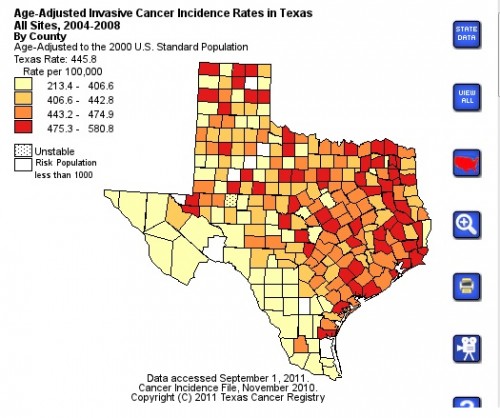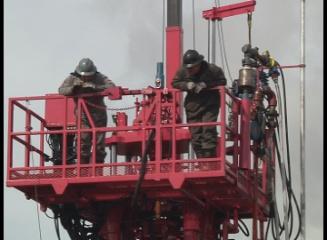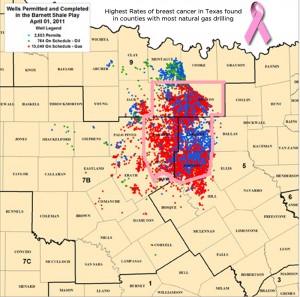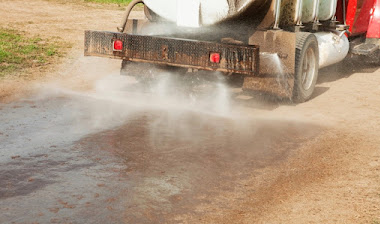Shale Reserve Estimate Slashed
August 24, 2011CEO Aubry McClendon speaks at the Marcellus Shale Insights Conference in Philadelphia, Pennsylvania
September 7, 2011http://dallasdrilling.wordpress.com/2011/09/01/breast-cancer-rates-jump-in-the-barnett-shale/
TEXAS CANCER REGISTRY MAP: TO FIND YOUR (Texas) COUNTY’S STATS (click here)
by TXsharon on August 31, 2011Time and time again, we’ve heard from the industry, State of Texas leaders, and local government leaders that apparently there is no connection between illness and shale gas drilling. They say that we have nothing to fear, that those who raise issues of concern are hysterical and rumor mongers. The shale gas industry tells us everyday on television via commercials that this is the ‘American way’, that it’s ours and we deserve it. If you speak against it, you’re unAmerican. You’re a trouble maker. You need to be quiet. Trust them.
Of course we all remember what the tobacco industry said decades ago about smoking and the lack of proof to cancer. Fast forward to today and it’s history repeating itself as it does quite frequently when you don’t listen to your inner voice.The Denton Record Chronicle’s, Peggy Heinkel-Wolfe has written a superb piece on the rate of breast cancer rates in the Barnett Shale area of Texas. Read about it here: CLICK THIS
Then as you can see below, a map showing the impact shale gas drilling has on Texas. You will notice that the counties in which you have heavier drilling activity perfectly matches the jump in breast cancer rates. Coincidence?
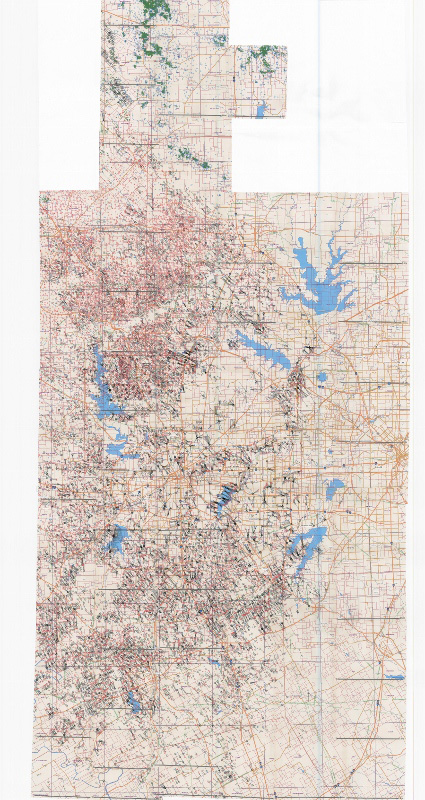
Map courtesy of the Texas Railroad Commission
Breast Cancer Rate Climbs Up
Six counties including Denton have state’s highest incidence rates
By Peggy Heinkel-Wolfe / Staff Writer03:18 PM CDT on Wednesday, August 31, 2011
Invasive breast cancer is on the rise in Denton County and five neighboring counties, even as the incidence rate for the disease is lower in the state and falling across the rest of the nation.
According to a 2011 report by the Centers for Disease Control and Prevention, six counties in the western Dallas-Fort Worth area have the highest rates of invasive breast cancer in Texas.
The average of the six counties’ rates has risen from 58.7 cases per 100,000 people in 2005 to about 60.7 per 100,000 in 2008, according to the Texas Cancer Registry.
While local breast cancer rates are up, they are still below the national average. In Texas, historically, breast cancer rates have been below the national average, experts say.
From 1975 to 1999, breast cancer rates nationwide rose from 103 breast cancers per 100,000 people to an all-time high of about 141. Those rates have dropped ever since, to about 127 per 100,000 in 2008, the latest year national data was available through the National Cancer Institute.
State and federal agencies track cancer data in order to work together to improve public health, according to Christie Eheman, an epidemiologist and chief of the Cancer Surveillance Branch in the CDC’s Division of Cancer Prevention and Control. The CDC’s 2011 report was part of communicating the agency’s efforts to use the data — in this case, to screen more patients and find breast cancer earlier.
“We do expect the registries to work together,” Eheman said.
The region’s high rates have been noted by cancer researchers who are studying it, but who are also unsure of the cause, according to Dr. Keith Argenbright, medical director of Moncrief Cancer Institute at UT Southwestern Medical Center in Dallas.
“We’re not entirely sure why that is happening,” Argenbright said, adding that it could be a mix of a number of factors.
The medical school has secured funds to conduct screenings, since those rates, too, are lower than the national average. For about every 1,000 screenings the medical school provides, they find about six new cases of breast cancer, Argenbright said, in part because the group targets low-income and underserved areas.
“Screening doesn’t help the incident rate, but it can help lower the mortality rate,” Argenbright said.
Nationwide, deaths from breast cancer have dropped markedly since the early 1990s, according to the National Cancer Institute.
The cause of breast cancer has been linked to a number of genetic and individual factors, such as smoking or the use of artificial hormones, according to the American Cancer Society. Recognizing the role of toxic exposures, the National Institute of Environmental Health Sciences and the National Cancer Institute funded the Breast Cancer and the Environment Research Program at research institutions in several Eastern states and in the San Francisco Bay Area.
Because the rise in local cancer rates occurred in the same counties as those with the Barnett Shale’s most intense gas drilling development, some residents are concerned about toxic exposures.
In 2010, the Texas Commission on Environmental Quality inventoried emissions sources from natural gas production equipment in all 24 counties of the Barnett Shale. The six counties with the most production equipment are Denton, Hood, Johnson, Parker, Tarrant and Wise counties — the same six counties with high breast cancer rates.
The six counties have a combined population of 3 million people and cover about 5,000 square miles.
Last year, Flower Mound residents asked for an investigation into childhood leukemia rates, believing there could be a cluster near Liberty Elementary School. State health officials found none, but in a report published by the Department of State Health Services, officials noted the uptick in breast cancer rates in that ZIP code.
“Finding cancer clusters has a very limited application in understanding environmental exposure, since statistical research methods work better when studying things that are big,” said Julia Brody, executive director of the Silent Spring Institute, a Massachusetts nonprofit research group examining environmental causes of breast cancer. The institute’s website includes a database of studies that have found links between breast cancers and toxic compounds, including studies of fuel- and combustion-related compounds as well as solvents.
While TCEQ toxicologists frequently include charts of long-term thresholds in their assessments of Barnett Shale air samples taken by Summa canister, they limit their analyses to short-term exposure levels, writing that long-term comparisons “are inappropriate.”
Using short-term standards is unacceptable for ongoing exposures, Brody said. “It’s better to use other methods, such as an exposure study,” she said.
Former Flower Mound resident Lorrie Squibb said it’s time for such an investigation. She was diagnosed with multiple myeloma, a blood cancer that is primarily associated with environmental exposure, two months after she moved to Michigan. She lived in Flower Mound from 2003 to 2010 in the same neighborhood seeking the cancer cluster investigation.
Squibb’s cancer is usually found in older men who have worked in a factory their entire lives, not a stay-at-home mom in her 40s, she said.
“My doctors believe I had my cancer for two years before I moved here [to Michigan],” Squibb said. “The first question they asked me was: ‘What have you been exposed to?'”
BY THE NUMBERS
According to the Texas Commission on Environmental Quality’s 2010 inventory of gas production equipment in the 24 counties of the Barnett Shale, the same six counties with rising rates of invasive breast cancer also have the highest count of compressors, separators, tanks and other above-ground points of emissions. Here is the number of emission points for the six leading counties.
Johnson: 10,859 points
Tarrant: 8,659 points
Denton: 7,812 points
Wise: 7,475 points
Parker: 4,707 points
Hood: 2,337 points
SOURCE: Texas Commission on Environmental Quality
Big Gas Mafia Irony BurnsTa-tas
http://www.texassharon.com/2011/09/02/big-gas-mafia-irony-burnsta-tas/
by TXsharon on September 2, 2011 in healthNormally, I love irony but this is irony burns the ta-tas.
Pink rig drilling to raise money for breast cancer
Pink rig drilling to raise money for breast cancer
Roughnecks go pink for breast cancer
It’s big, pink, costs more than $1 million and is raising money for breast cancer research every day. This pink machine is doing two very important jobs at once
Job One: Make billions in profit for CEO.
Job Two: Give cash to breast cancer research so no one notices breast cancer has increased in the Gas Patch.
UPDATE: It gets even better . . .
Williams fined $423K for contamination of spring near Parachute
Amount reduced due to ‘prompt, effective and prudent response’
The COGCC’s investigation concluded that Williams’ gas drilling activities, and particularly a leaking liner used in a pit to contain water laced with hydrocarbons and chemicals, contaminated the spring in question. The investigation revealed the presence of benzene, a carcinogenic chemical known to be used in some of the procedures involved in gas exploration.
Multiple studies point to a correlation between benzene exposure and breast cancer risk.
Benzene
Benzene is a petrochemical solvent. Benzene exposure mostly originates from air pollution resulting from industrial burning, exhaust and gas fumes, as well as cigarette smoke. The International Agency for Research on Cancer and the National Toxicology Program have labeled benzene as a definite human carcinogen. Multiple studies point to a correlation between benzene exposure and breast cancer risk. Laboratory studies on mice have shown that a high level of benzene exposure can lead to mammary cancer. [63]
[63]^ a b c d e f g State of the Evidence, The Connection Between Breast Cancer and the Environment, 2008

